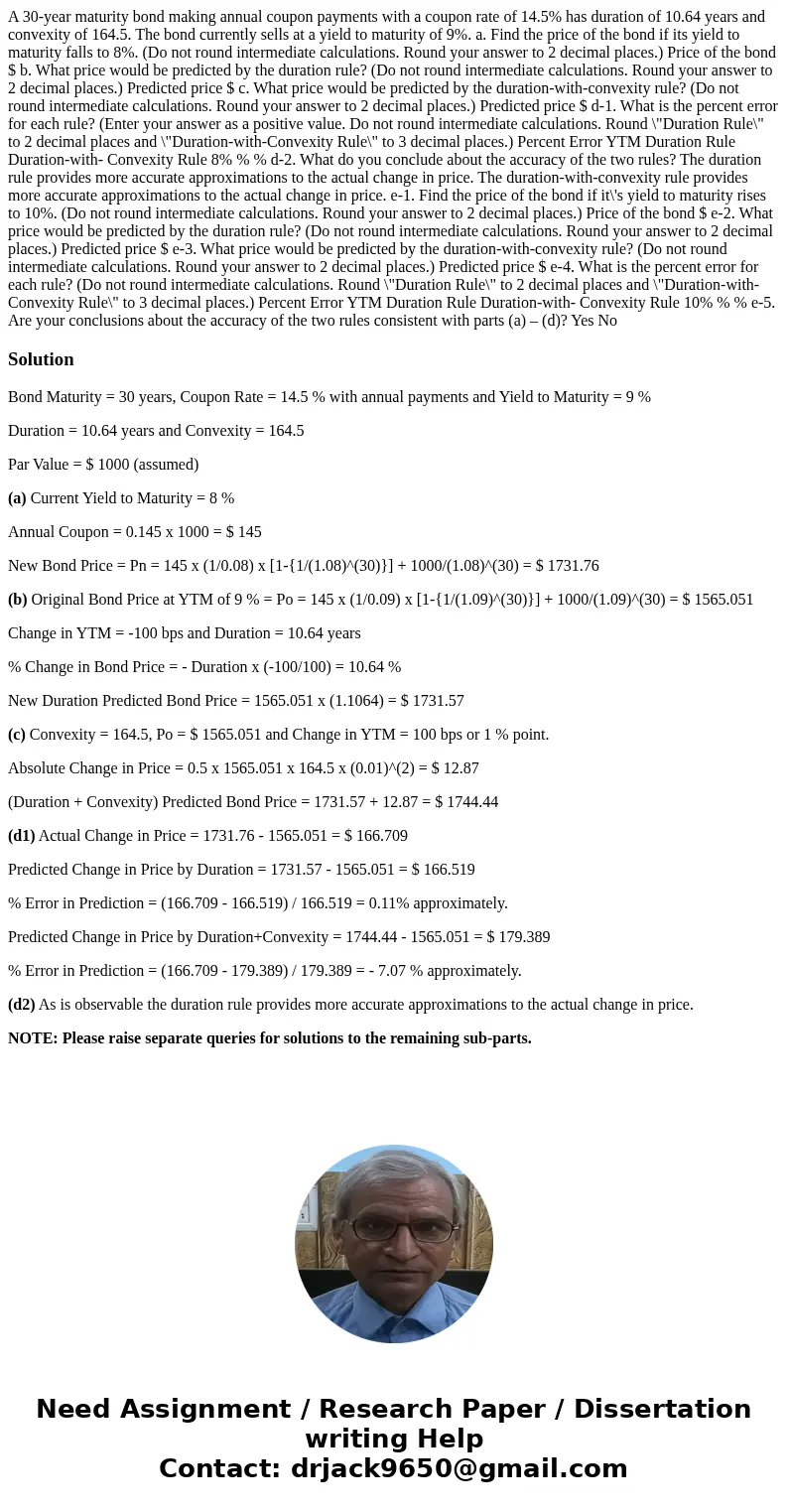A 30year maturity bond making annual coupon payments with a
A 30-year maturity bond making annual coupon payments with a coupon rate of 14.5% has duration of 10.64 years and convexity of 164.5. The bond currently sells at a yield to maturity of 9%. a. Find the price of the bond if its yield to maturity falls to 8%. (Do not round intermediate calculations. Round your answer to 2 decimal places.) Price of the bond $ b. What price would be predicted by the duration rule? (Do not round intermediate calculations. Round your answer to 2 decimal places.) Predicted price $ c. What price would be predicted by the duration-with-convexity rule? (Do not round intermediate calculations. Round your answer to 2 decimal places.) Predicted price $ d-1. What is the percent error for each rule? (Enter your answer as a positive value. Do not round intermediate calculations. Round \"Duration Rule\" to 2 decimal places and \"Duration-with-Convexity Rule\" to 3 decimal places.) Percent Error YTM Duration Rule Duration-with- Convexity Rule 8% % % d-2. What do you conclude about the accuracy of the two rules? The duration rule provides more accurate approximations to the actual change in price. The duration-with-convexity rule provides more accurate approximations to the actual change in price. e-1. Find the price of the bond if it\'s yield to maturity rises to 10%. (Do not round intermediate calculations. Round your answer to 2 decimal places.) Price of the bond $ e-2. What price would be predicted by the duration rule? (Do not round intermediate calculations. Round your answer to 2 decimal places.) Predicted price $ e-3. What price would be predicted by the duration-with-convexity rule? (Do not round intermediate calculations. Round your answer to 2 decimal places.) Predicted price $ e-4. What is the percent error for each rule? (Do not round intermediate calculations. Round \"Duration Rule\" to 2 decimal places and \"Duration-with-Convexity Rule\" to 3 decimal places.) Percent Error YTM Duration Rule Duration-with- Convexity Rule 10% % % e-5. Are your conclusions about the accuracy of the two rules consistent with parts (a) – (d)? Yes No
Solution
Bond Maturity = 30 years, Coupon Rate = 14.5 % with annual payments and Yield to Maturity = 9 %
Duration = 10.64 years and Convexity = 164.5
Par Value = $ 1000 (assumed)
(a) Current Yield to Maturity = 8 %
Annual Coupon = 0.145 x 1000 = $ 145
New Bond Price = Pn = 145 x (1/0.08) x [1-{1/(1.08)^(30)}] + 1000/(1.08)^(30) = $ 1731.76
(b) Original Bond Price at YTM of 9 % = Po = 145 x (1/0.09) x [1-{1/(1.09)^(30)}] + 1000/(1.09)^(30) = $ 1565.051
Change in YTM = -100 bps and Duration = 10.64 years
% Change in Bond Price = - Duration x (-100/100) = 10.64 %
New Duration Predicted Bond Price = 1565.051 x (1.1064) = $ 1731.57
(c) Convexity = 164.5, Po = $ 1565.051 and Change in YTM = 100 bps or 1 % point.
Absolute Change in Price = 0.5 x 1565.051 x 164.5 x (0.01)^(2) = $ 12.87
(Duration + Convexity) Predicted Bond Price = 1731.57 + 12.87 = $ 1744.44
(d1) Actual Change in Price = 1731.76 - 1565.051 = $ 166.709
Predicted Change in Price by Duration = 1731.57 - 1565.051 = $ 166.519
% Error in Prediction = (166.709 - 166.519) / 166.519 = 0.11% approximately.
Predicted Change in Price by Duration+Convexity = 1744.44 - 1565.051 = $ 179.389
% Error in Prediction = (166.709 - 179.389) / 179.389 = - 7.07 % approximately.
(d2) As is observable the duration rule provides more accurate approximations to the actual change in price.
NOTE: Please raise separate queries for solutions to the remaining sub-parts.

 Homework Sourse
Homework Sourse